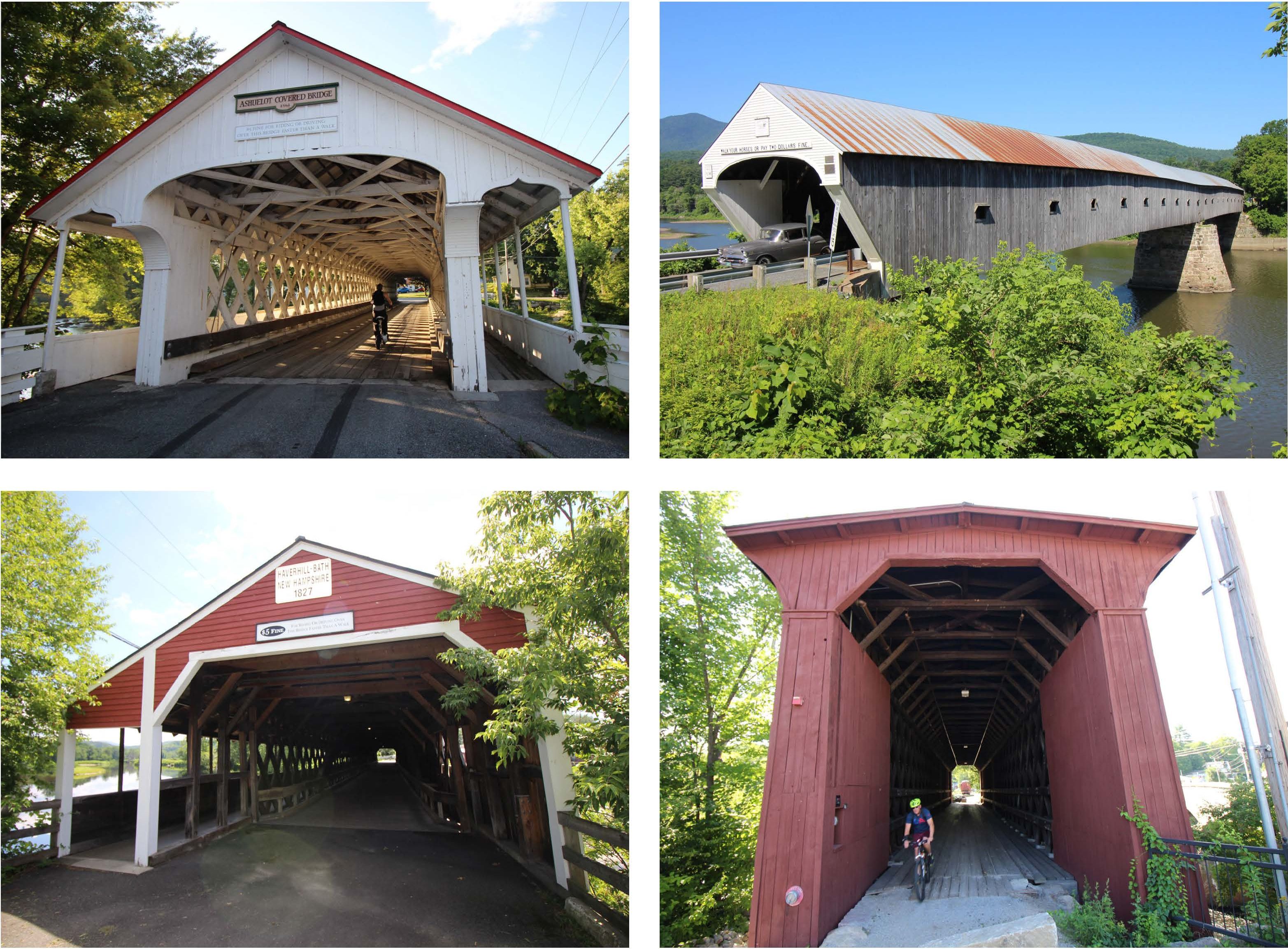
As the U.S. expanded in the 1800s, Americans refined timber-truss design to a degree never seen before and built some 10,000 covered bridges across the country. But only about 600 of these historic structures remain.
In many ways, American engineering began with innovative timber-truss bridges built in the early 1800s. In this slideshow, the editors of Invention & Technology Magazine describe 30 of the most celebrated covered bridges in the U.S., and tell why they are important.
For more information, see the accompanying article, "The History of American Covered Bridges" by Lola Bennett in the Fall 2020 issue of Invention & Technology.
The editors of I&T wish to thank Christopher Marston, Lola Bennett, and their colleagues at the National Covered Bridges Recording Project of the National Park Service, which has documented so many of the historic bridges in the U.S.
We also thank Bill Caswell and the other volunteers at the National Society for the Preservation of Covered Bridges for the important work they are doing.
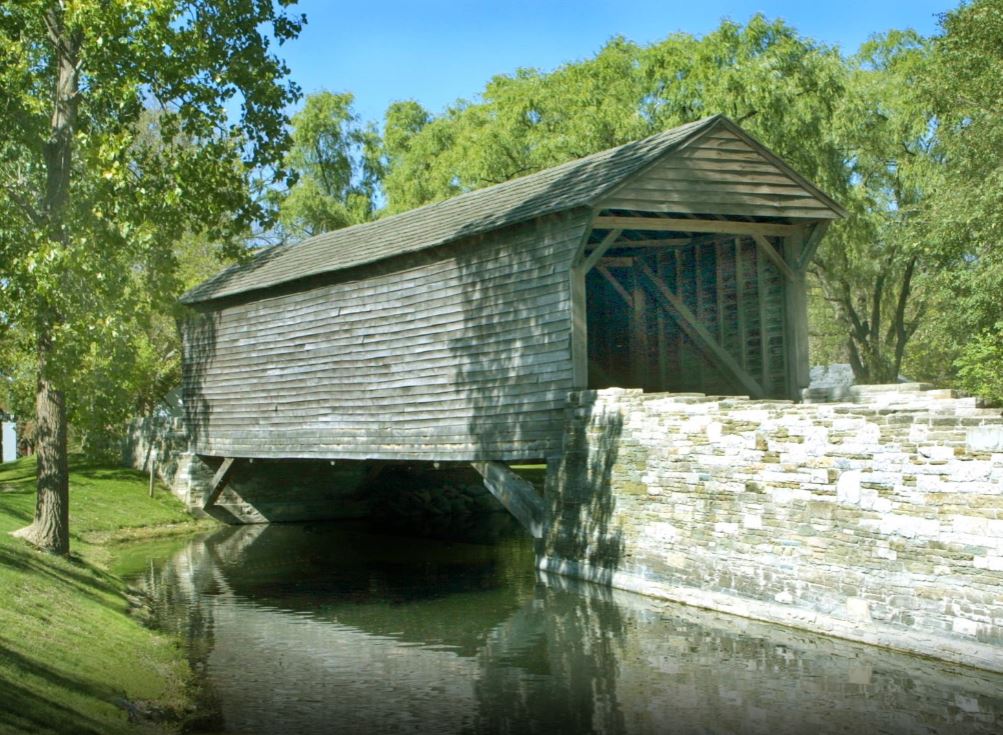
Ackley Bridge is an excellent example of a multiple kingpost truss and a noteworthy early exemplar of covered bridge preservation efforts in the U.S.
Where: The Ford Museum, Dearborn, Michigan
When Built: 1832
Builders: Joshua Ackley and Daniel Clouse
Truss: Multiple Kingpost
Built in 1832 by Joshua Ackley (b.1805) and Daniel Clouse (b.1812), the Ackley Bridge originally spanned a branch of Wheeling Creek between Greene and Washington Counties in Pennsylvania, where it carried traffic for more than a century.
In 1937, when the bridge was slated for replacement, one of Ackley’s descendents acquired the structure and offered it to industrialist Henry Ford for his open-air village museum at Dearborn, Michigan. That winter, the 80-foot covered bridge was carefully dismantled and transported to Greenfield Village where it was re-erected over a man-made pond.
The structure underwent repairs in 1974, stabilization in 1999, and restoration in 2000.
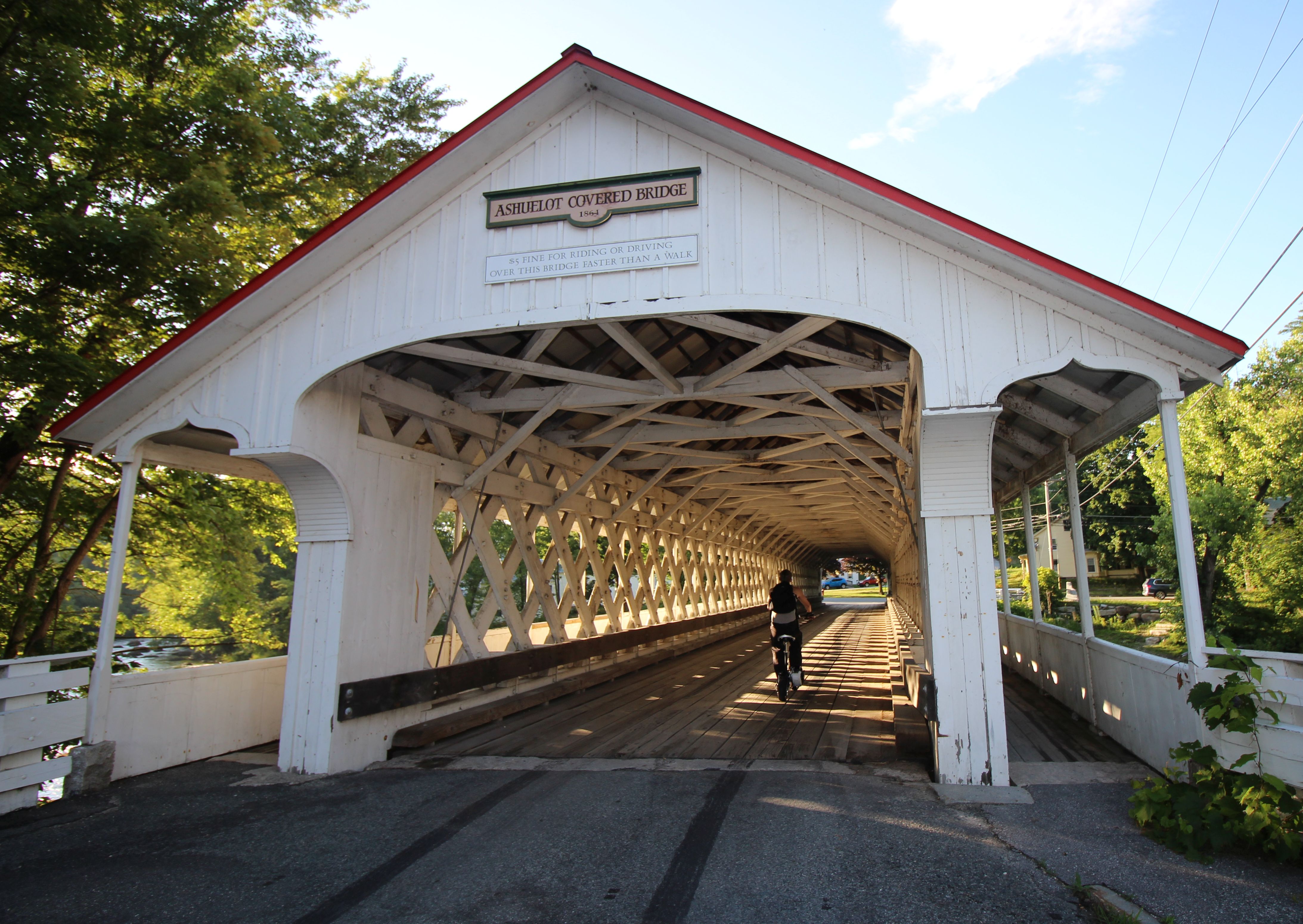
The Ashuelot Covered Bridge in New Hampshire is unusual in that its sides are not sheathed, allowing for more light into the interior.
Where: Ashuelot, NH
When Built: 1865
Truss: Town lattice
The Ashuelot Covered Bridge in the center of Ashuelot village spans the Ashuelot River in a roughly north-south orientation. It consists of two spans with a total length of 178 feet and width of 29 feet. Its Town lattice truss allows light into the central roadway and sidewalks on each side. One unusual feature of this bridge is that its sides are only sheathed to the height of the walkway handrails. Instead, the bridge roof is extended to create long eaves extend past the walkways, offering protection from the weather for both the trusses and the people who use the bridge.
The bridge rests on a central pier and stone abutments that have been reinforced with concrete since the bridge was built. The central pier is protected by a metal breakwater. The bridge passes 11'7" over the water.
Apparently a bridge was already standing at this site before the current bridge was completed in 1865 since older beams were found when repairs were made to the bridge after the New England Hurricane of 1938.
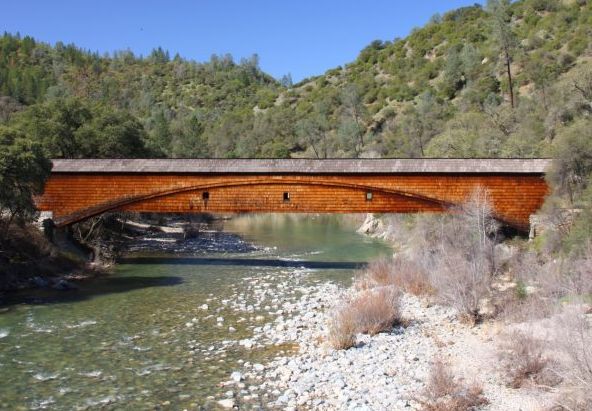
Bridgeport Bridge is the longest single-span covered bridge in the U.S. and a remarkable example of nineteenth-century timber bridge engineering.
Where: French Corral, California
When Built: 1862
Builder: Unknown
Truss: Howe
With a clear span of 209’, this Howe truss bridge with auxiliary arches is the longest covered bridge with only a single span in the United States. (Cornish-Windsor has two spans.) It was erected in 1862 for the Virginia City Turnpike, a major route into the Sierra Mountains during the California Gold Rush, and spans the South Yuba River .
Nevada County purchased the bridge in 1901, which continued to carry traffic until it was bypassed in 1973. In the late 1980s, the State of California purchased the bridge from Nevada County and developed the South Yuba River State Park.
Bridgeport Bridge was designated a National Historic Civil Engineering Landmark by the American Society of Civil Engineers in 1970 and listed in the National Register of Historic Places in 1971. This bridge possesses a high degree of integrity and is proposed for National Historic Landmark consideration. However, the span was recently closed due to structural problems and its future is uncertain.
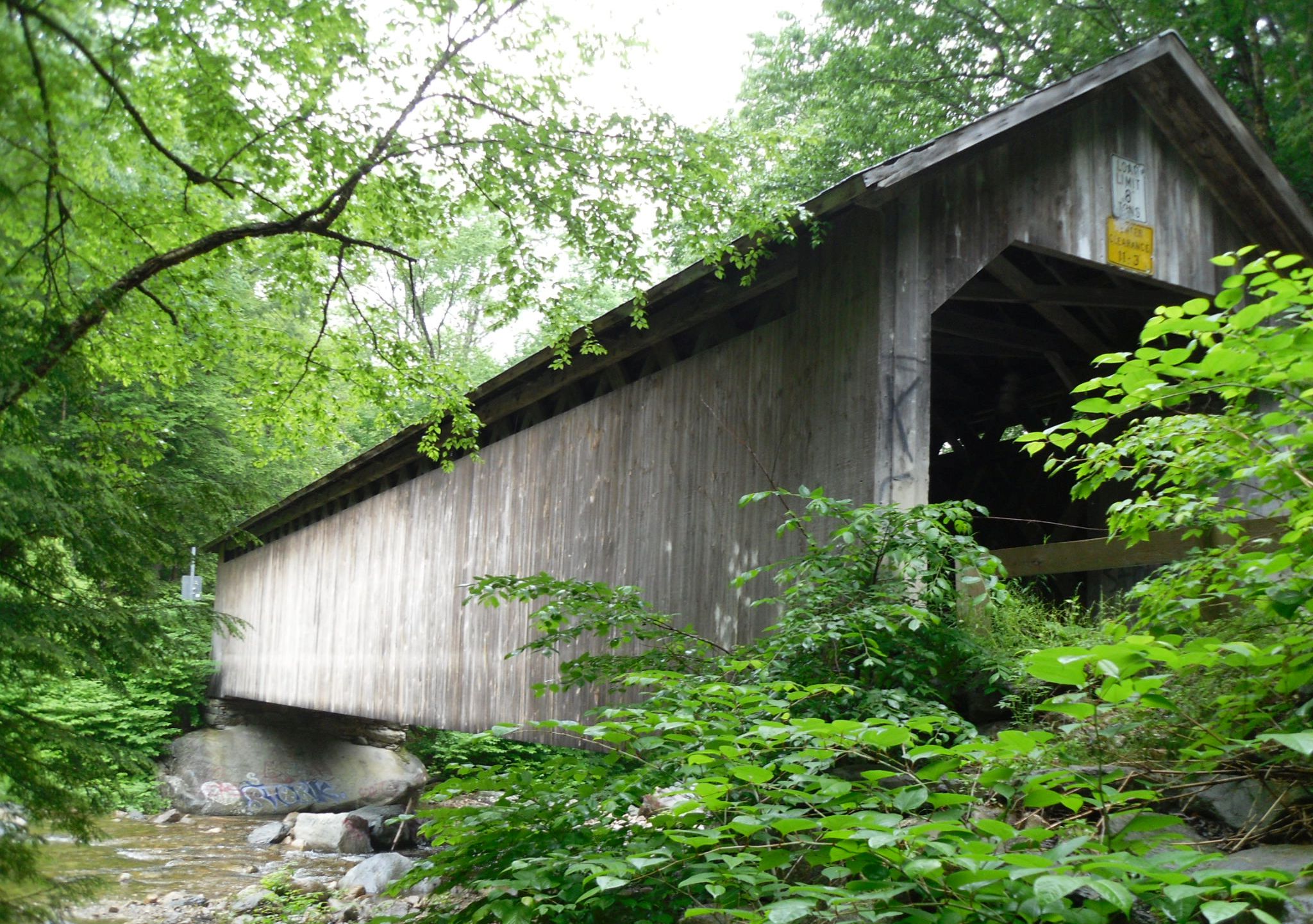
Brown Bridge is an outstanding example of nineteenth-century covered bridge construction.
Where: Shrewsbury, Vermont
When Built: 1880
Builder: Nichols M. Powers
Truss: Town lattice
Brown Bridge is an outstanding example of nineteenth-century covered bridge construction, and an exceptionally fine example of the Town lattice truss, one of the most widely used timber bridge designs.
Built in 1880, it is the last bridge erected by preeminent New England bridge builder Nichols M. Powers (1817-1897). The bridge’s unusual slate roof and the northwest abutment, which makes use of a huge natural boulder, illustrate how nineteenth-century builders used indigenous materials in building covered bridges.
Located on a rural road, Brown Bridge never carried heavy traffic and has required only routine maintenance since its construction. It was listed in the National Register of Historic Places in 1974 and, because its structure has a high level of historic integrity, it was named a National Historic Landmark.
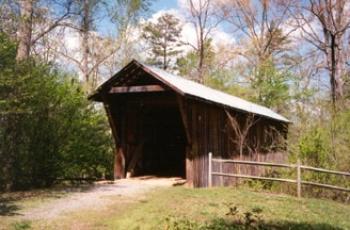
Bunker Hill Bridge is the only surviving Haupt truss bridge in the U.S. and one of only two surviving covered bridges in North Carolina.
Where: 4160 US-70, Claremont, North Carolina
Year Built: 1895
Builder: Andrew L. Ramsour
Truss: Haupt
Bunker Hill Bridge is the only surviving Haupt truss bridge in the U.S. and one of only two surviving covered bridges in North Carolina. Patented in 1839, the Haupt truss featured diagonal braces spanning multiple panels, which was an attempt to eliminate the cross-strain found in lattice truss bridges. Although it was almost immediately eclipsed by the Howe truss and never reached the mainstream of covered bridge building, the Haupt truss is of interest for its association with Gen. Herman Haupt (1817-1905), a nationally renowned engineer, who pioneered the structural analysis of bridges and was in charge of military bridges for the Union during the Civil War.
Bunker Hill Bridge was built by local carpenter Andrew L. Ramsour (1817-1906), who may have been inspired by earlier Haupt truss bridges in the region. The bridge carried local traffic until the 1920s, when it was bypassed and closed to traffic; it continued to carry farm vehicles into the 1930s. Bunker Hill Bridge was listed in the National Register of Historic Places in 1971 and was designated a National Historic Civil Engineering Landmark by the American Society of Civil Engineers in 2000. The bridge possesses a high degree of integrity and is proposed for National Historic Landmark consideration.
The Catawba County Historical Association has maintained the structure since 1985 and is currently renovating it. Information is at: https://catawbahistory.org/bunker-hill-covered-bridge.


